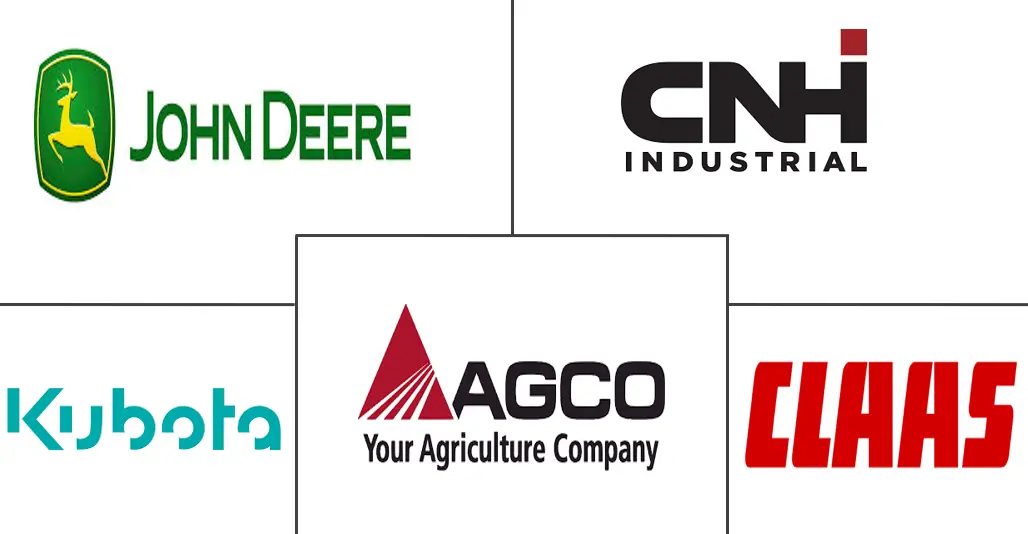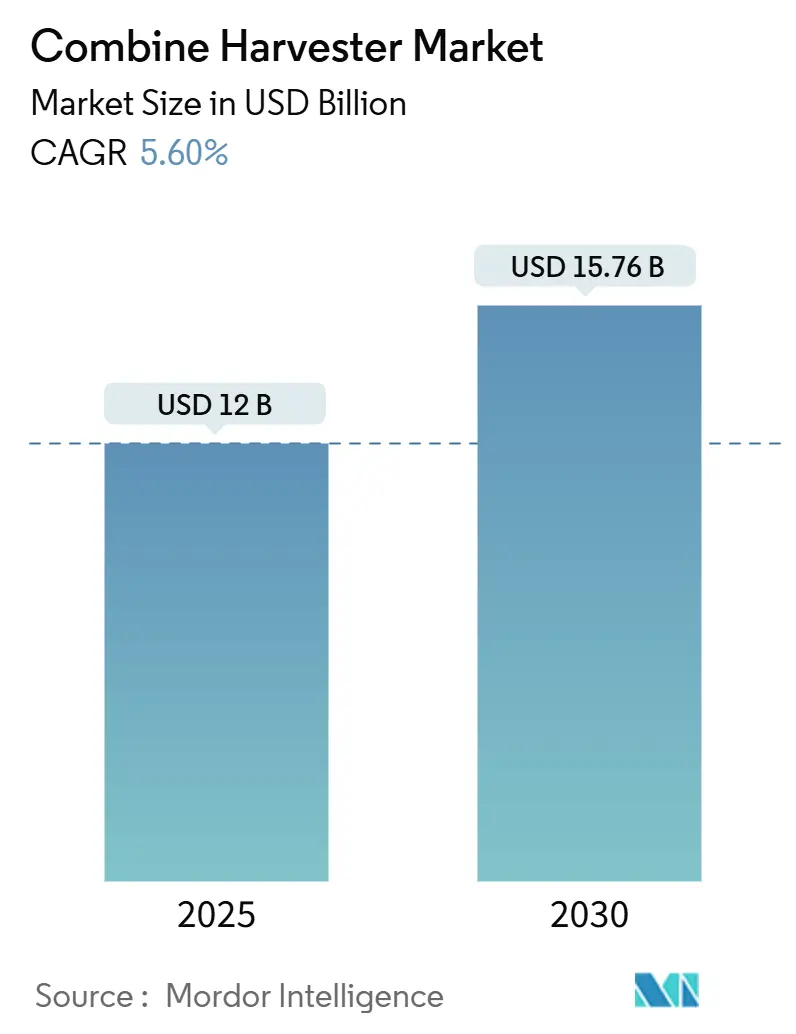
Combine Harvester Market Analysis by Mordor Intelligence
The combine harvester market size stands at USD 12 billion in 2025 and is forecast to reach USD 15.76 billion by 2030, expanding at a 5.6% CAGR. The outlook reflects sturdy demand for high-capacity harvesters, steady adoption of precision agriculture suites, and manufacturers' pivot toward embedded software that monetizes data analytics. Rising government mechanization subsidies across Asia-Pacific, persistent rural labor shortages in developed economies, and a corporate shift toward subscription-based service models collectively reinforce the upward revenue trajectory. Competitive pressure now revolves around throughput gains, autonomy readiness, and soil-friendly chassis redesigns that comply with emerging compaction rules. Rapid mechanization in China and India, supportive European programs, and North American right-to-repair legislation are reshaping buyer priorities.
Key Report Takeaways
- By type, self-propelled models led with 72% combine harvester market share in 2024; the tractor-pulled combine is projected to advance at a 7.8% CAGR through 2030.
- By power output, the 301–450 HP class accounted for 38% of the combine harvester market size in 2024, while machines above 450 HP are slated to post the fastest 7.4% CAGR to 2030.
- By geography, North America retained 32.2% revenue share in 2024, whereas Asia-Pacific is pacing an 8.2% CAGR to 2030 that outstrips every other region.
Global Combine Harvester Market Trends and Insights
Drivers Impact Analysis
| Driver | (~) % Impact on CAGR Forecast | Geographic Relevance | Impact Timeline |
|---|---|---|---|
| Rising farm mechanization in emerging economies | +1.8% | Asia-Pacific, Africa, and South America | Medium term (2-4 years) |
| Persistent rural labor shortage and wage inflation | +1.5% | Global, with concentration in North America and Europe | Short term (≤ 2 years) |
| Adoption of precision-ag mechanization suites | +1.2% | North America, Europe, and Australia | Medium term (2-4 years) |
| Integration of AI-enabled predictive maintenance | +0.8% | Global, early adoption in developed markets | Long term (≥ 4 years) |
| Carbon-credit monetization for low-loss harvesting | +0.5% | Global, regulatory focus in Europe and California | Long term (≥ 4 years) |
| OEM financing platforms targeting smallholders | +0.7% | Asia-Pacific, Africa, and South America | Medium term (2-4 years) |
| Source: Mordor Intelligence | |||
Rising Farm Mechanization in Emerging Economies
Government grants and custom-hiring hubs continue to widen equipment access. India’s Sub-Mission on Agricultural Mechanization reimburses 40–50% of purchase costs and has deployed more than 40,900 rental centers, lifting mechanization from 40% toward China’s 60% benchmark[1]Source: Press Information Bureau, “Mechanisation of Indian Agriculture,” pib.gov.in. China’s policy goal of 75% mechanization by 2025 attracts multinational suppliers into joint ventures that sidestep import tariffs[2]Source: International Trade Administration, “China Agricultural Machinery Market,” trade.gov. Similar subsidy schemes in Brazil and multiple African nations illustrate a structural push that enlarges the combine harvester market.
Persistent Rural Labor Shortage and Wage Inflation
Unemployment below 3% in many grain belts has lifted farm wages to record highs, narrowing the payback window for autonomous threshing platforms. Large U.S. growers now cite workforce scarcity as the primary justification for migrating to high-horsepower combines configured for one-operator, multi-shift deployment. Western Europe mirrors this tension, with dairy and arable producers trimming acreage whenever harvest labor cannot be secured in time. This labor scarcity is particularly acute during harvest seasons when timing is critical, driving demand for high-capacity combines that can maximize operational windows with minimal human intervention.
Adoption of Precision-Ag Mechanization Suites
Sensor-driven automation is transitioning from an optional overlay to an embedded standard. Leading Original Equipment Manufacturers (OEM) bundle yield-mapping, loss-monitoring, and ground-speed algorithms that promise 15–20% throughput gains for average operators. Subscription portals translate machine data into actionable agronomy advice, generating a recurring revenue layer that cushions cyclical equipment sales dips. The functionality jump cements precision software as the next competitive battleground inside the combine harvester market. These systems generate valuable data streams that enable predictive maintenance and operational optimization, creating recurring revenue opportunities through subscription-based services.
Integration of AI-Enabled Predictive Maintenance
Real-time diagnostics avert costly in-season breakdowns. Cloud-linked cameras flag grain-quality deviations, while vibration analytics model component fatigue to schedule parts replacement before failure. Early adopter fleets show 15–25% downtime reductions, extending engine life and stabilizing residual values. As connectivity fees expire, OEMs increasingly shift users onto annual telematics plans that enlarge aftermarket margins. These systems reduce the traditional reactive maintenance model, potentially decreasing equipment downtime during peak harvest seasons.
Restraints Impact Analysis
| Restraint | (~) % Impact on CAGR Forecast | Geographic Relevance | Impact Timeline |
|---|---|---|---|
| High upfront capital requirement | -1.2% | Global, particularly acute in developing markets | Short term (≤ 2 years) |
| Limited aftermarket service networks | -0.8% | Asia-Pacific, Africa, and rural regions globally | Medium term (2-4 years) |
| Dependence on volatile commodity crop pricing | -1.0% | Global, cyclical impact | Short term (≤ 2 years) |
| Rapid soil-compaction regulations | -0.6% | Europe and North America, expanding globally | Long term (≥ 4 years) |
| Source: Mordor Intelligence | |||
High Upfront Capital Requirement
New flagship frequently lists between USD 400,000 and USD 500,000. Elevated interest rates push annual carrying costs per unit, lengthening break-even periods even for well-capitalized farms. Although leasing and operating-rent contracts soften the blow, smaller growers still postpone purchases, slowing near-term combine harvester market growth. AGCO's strategic focus on OEM financing solutions and John Deere's expansion of financing capabilities in Brazil demonstrate manufacturers' recognition that equipment accessibility depends increasingly on innovative payment structures rather than traditional purchase models.
Limited Aftermarket Service Networks
Precision hardware demands technicians fluent in both hydraulics and machine-learning diagnostics. Coverage gaps across sub-Saharan Africa and parts of the Association of Southeast Asian Nations (ASEAN) leave owners exposed to harvest-time downtime. Digital service portals offer partial relief, yet physical parts depots and trained field engineers remain indispensable. Manufacturers are responding through digital service platforms and remote diagnostic capabilities, but the fundamental constraint of geographic service coverage remains a significant barrier to market penetration in rural regions where combine harvesters are most needed.
Segment Analysis
By Type: Self-Propelled Dominance Drives Innovation
Self-propelled machines generated 72% combine harvester market share in 2024, underscoring their primacy in high-acreage operations. Tractor-pulled variants alone are projected to lift the segment’s CAGR to 7.8% through 2030 as dual-flow threshing boosts grain retention. PTO-powered models remain viable among cost-sensitive growers, but ongoing autonomy retrofits are beginning to blur legacy category lines. The tractor-mounted niche endures in cost-sensitive or fragmented landholdings, especially where capital pools are modest. Manufacturers refine hybrid drivelines that lower fuel by up to 10%, raising appeal for operators juggling diesel, ad-blue, and maintenance costs.
Fleet owners favor self-propelled platforms for their tight turning radius, integrated telematics, and compatibility with 12- to 18-row headers. OEMs now release over-the-air firmware that tunes concave clearance and rotor speed to crop moisture, squeezing extra throughput from existing horsepower bands. As adherence to future compaction rules tightens, articulated undercarriages and wide-track options gain traction within this leading type segment of the combine harvester market. The segment’s innovation pipeline centers on the combined harvesters market size expansion through autonomous modules that let a single driver supervise multiple units across adjoining fields.
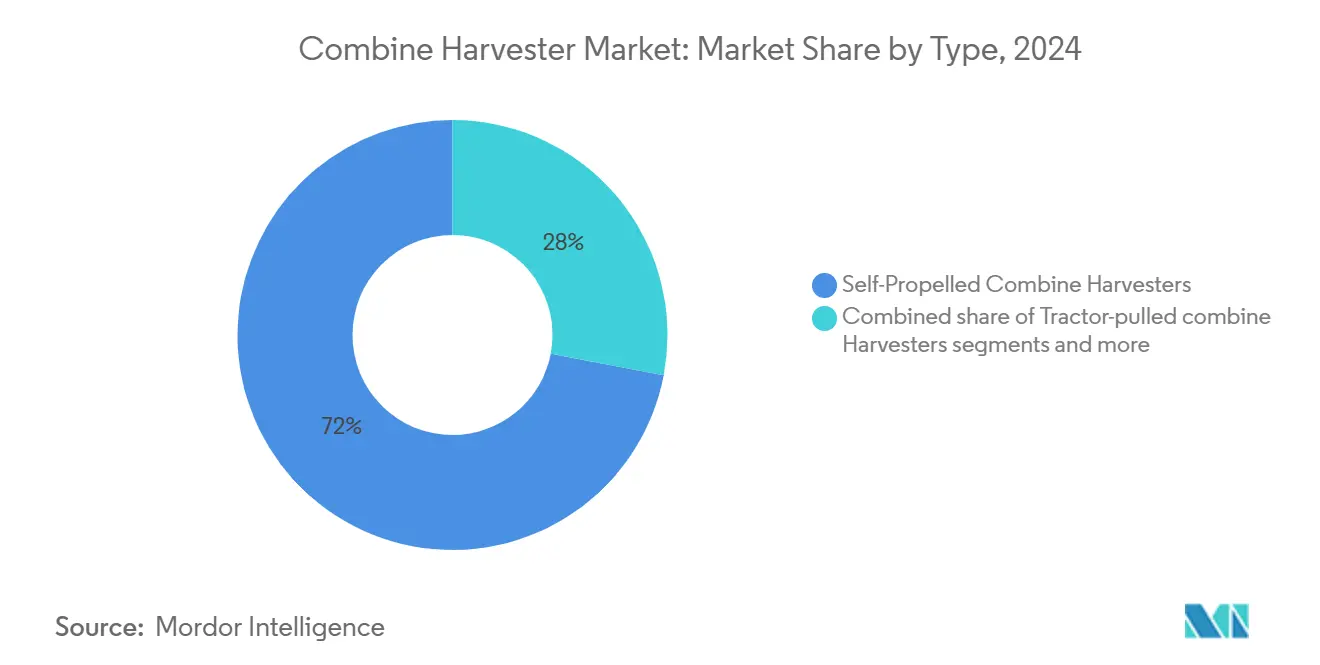
Note: Segment shares of all individual segments available upon report purchase
By Power Output: High-Horsepower Segment Captures Premium Demand
The 301–450 HP cohort accounted for 38% of the combine harvester market size in 2024 due to its cost-capacity balance. Units exceeding 450 HP, however, headline a 7.4% CAGR to 2030 as mega-farms in North and South America consolidate fields and compress harvest calendars. Elevated grain prices during cyclical upswings further justify these machines, whose 45-foot drapers and 18-row corn heads clear acreage at unrivaled speed.
Below 150 HP models cater to specialty crops and steep-slope regions where maneuverability trumps brute force. The 151–300 HP class addresses mid-size holdings seeking multi-crop flexibility. Across all brackets, Tier 4 and emerging Tier 5 emissions thresholds prompt engine recalibration and selective catalytic reduction upgrades, nudging buyers toward cleaner yet more complex powertrains.
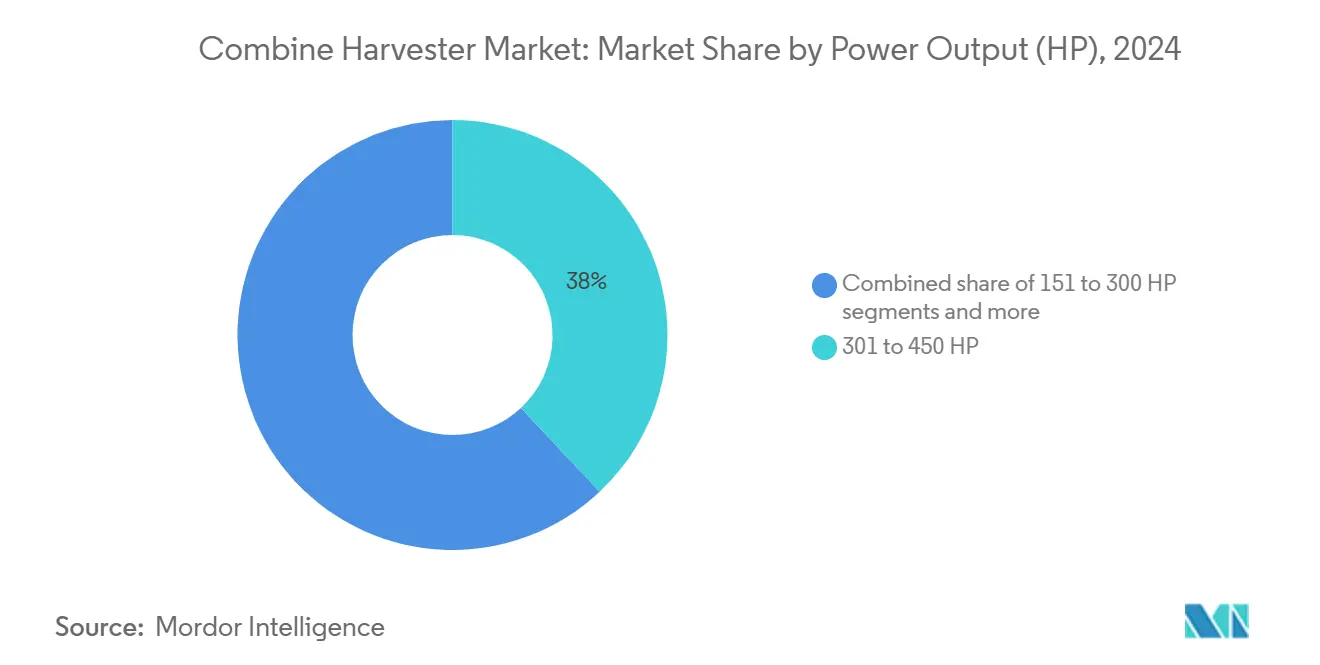
Note: Segment shares of all individual segments available upon report purchase
Geography Analysis
North America retained 32.2% revenue in 2024, reflecting deep mechanization and entrenched replacement cycles. Capital spending nonetheless softened as growers braced for a predicted dip in large-equipment deliveries during 2025. Federal aid earmarked for climate-smart agriculture may cushion orders in the latter half of the year, especially for combines outfitted with residue-balancing kits that qualify for soil-health grants. Canada's agricultural sector benefits from strong grain export demand and government support for precision agriculture adoption, while Mexico's growing agricultural mechanization presents expansion opportunities for North American manufacturers.
Asia-Pacific leads growth at an 8.2% CAGR through 2030. India’s mechanization gap has narrowed swiftly; subsidy-backed custom-hiring centers now finance threshing sessions for smallholders who cannot yet buy machines outright. China’s 75% mechanization target propels demand for domestically assembled high-end combines that avoid import tariffs while retaining foreign sensor suites. Japan and Australia represent mature markets with a focus on precision agriculture and automation technologies, while Southeast Asian countries present emerging opportunities as agricultural productivity demands increase.
Europe’s market cools amid input-cost inflation and stricter environmental mandates. The EU Machinery Regulation 2023/1230 sets new guardrails for autonomous safety validation, raising R&D budgets for compliance[3]Source: European Parliament and Council, “Regulation (EU) 2023/1230 on Machinery,” eur-lex.europa.eu. In contrast, Brazil and Argentina ride export-led cash flows that fund upgrades to 350 HP-plus combines equipped with telematics pods that simplify fleet optimization. South America benefits from a strong agricultural export performance, with Brazil's record sugarcane processing of 713 million tons in 2023 supporting equipment demand, while Argentina's agricultural biotechnology leadership creates opportunities for precision agriculture integration.
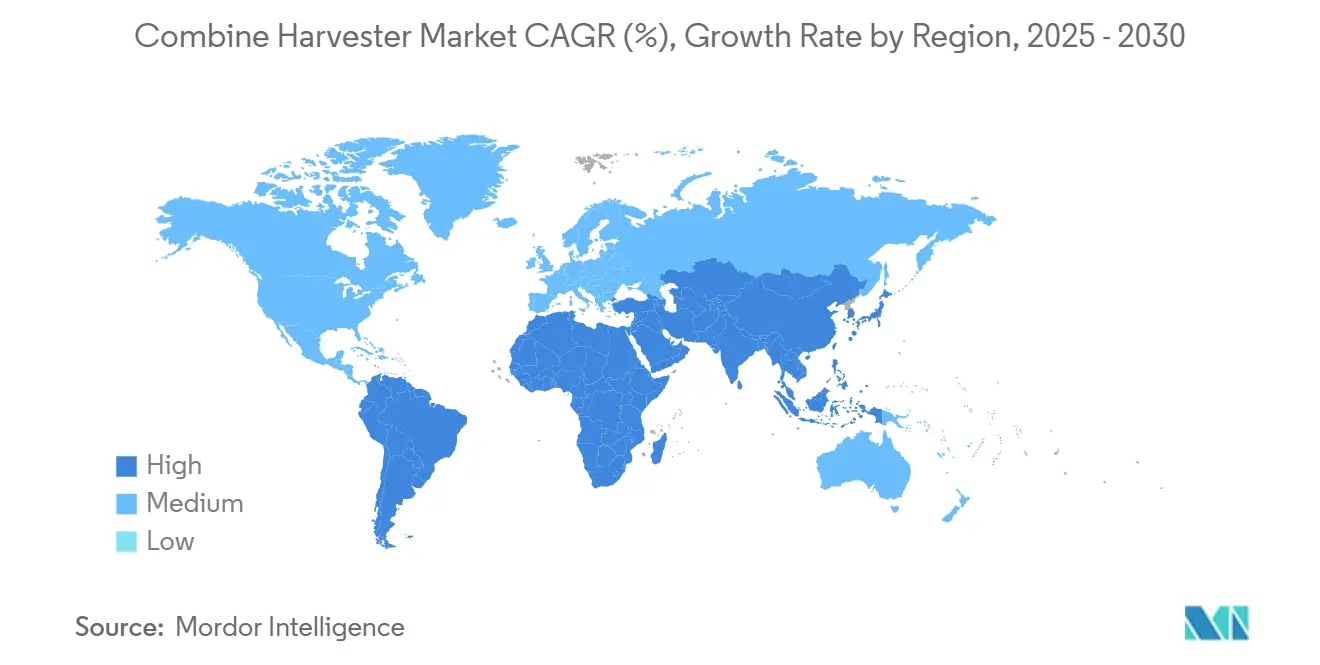
Competitive Landscape
The Combine Harvester Market concentration is moderately consolidated. Top manufacturers Deere & Company, CNH Industrial N.V., Kubota Corporation, AGCO Corporation, and Claas KGaA mbH control the lion’s share of the combine harvester market. Their combined R&D muscle funds rapid cycles of header, automation, and drivetrain upgrades. AGCO Corporation’s USD 2 billion purchase of 85% of Trimble Ag in 2023 underscores a race to secure precision-ag IP that scales across mixed-brand fleets. CNH Industrial N.V. targets 16-17% mid-cycle EBIT margins (Earnings Before Interest and Taxes) by embedding digital services and introducing the AF10 series with 775 HP and 15% lower cost of ownership.
Strategic partnerships mirror the sector’s shift from metal to microchips. New Holland’s pact with Bluewhite introduces autonomous retrofits that claim 85% labor savings in specialty crops. Deere & Company teams with satellite providers to extend machine connectivity, enabling over-the-air updates and cross-farm fleet coordination. Meanwhile, right-to-repair litigation forces OEMs to balance software protection with farmer goodwill.
Regional challengers chase niches: Kubota Corporation dominates Asian rice machinery with sub-200 HP combines, while Rostselmash deepens presence in Eastern Europe. Component suppliers such as Linamar, fresh from acquiring Bourgault, aim to plug into OEM autonomy stacks with smart header controls. Market entrants must navigate certification barriers, tight dealer hierarchies, and high tooling costs for Tier 4 final engines.
Combine Harvester Industry Leaders
-
Deere & Company
-
Kubota Corporation
-
Claas KGaA GmbH
-
AGCO Corporation
-
CNH Industrial N.V.
- *Disclaimer: Major Players sorted in no particular order
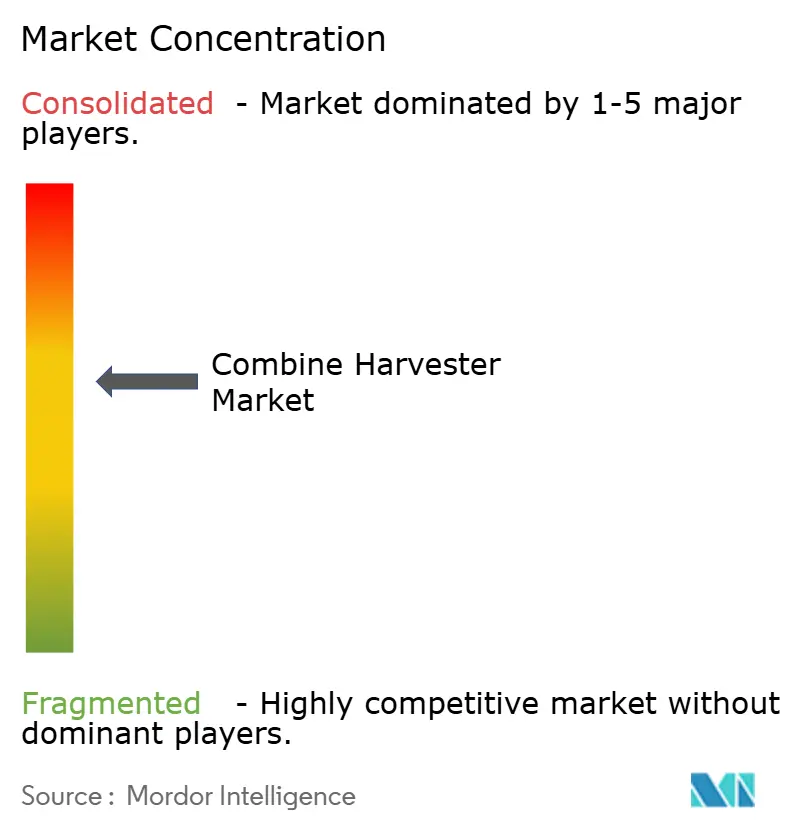
Recent Industry Developments
- June 2025: John Deere introduced the F8 and F9 Series self-propelled forage harvesters with advanced automation features including Ground Speed Automation and ProTouch Harvest, offering engine options ranging from 425PS to 1020PS to address diverse operational requirements.
- February 2025: John Deere unveiled next-generation combine front-end equipment, including a three-piece hinged draper reel system and an 18-row corn head designed for enhanced efficiency, alongside expanded automation features, including predictive ground speed automation and harvest settings optimization.
- May 2024: Case IH launched the Axial-Flow 260 series combine harvester featuring subscription-free integrated technology, including Harvest Command automation, Pro 1200 Dual Displays, and ActiveTrac four-roller hydraulic suspended track system designed to reduce soil compaction while improving grain quality and operational efficiency.
Global Combine Harvester Market Report Scope
A combine harvester, a versatile agricultural machine, is designed to efficiently harvest various cereal crops, including wheat, corn, rice, barley, oats, and soybeans. The combine harvesters market is segmented by type into Self-Propelled, Tractor-Pulled Combine, and PTO-Powered Combine and by Geography into North America, Europe, Asia-Pacific, South America, and Africa. The report offers market size and forecasts in terms of value (USD) for all the above segments.
| Self-propelled |
| Tractor-pulled combine |
| PTO-powered combine |
| Less than 150 HP |
| 151 to 300 HP |
| 301 to 450 HP |
| Above 450 HP |
| North America | United States |
| Canada | |
| Mexico | |
| Rest of North America | |
| South America | Brazil |
| Argentina | |
| Rest of South America | |
| Europe | Germany |
| France | |
| United Kingdom | |
| Spain | |
| Italy | |
| Russia | |
| Rest of Europe | |
| Asia-Pacific | China |
| India | |
| Japan | |
| Australia | |
| Rest of Asia-Pacific | |
| Middle East | Saudi Arabia |
| Turkey | |
| Rest of Middle East | |
| Africa | South Africa |
| Egypt | |
| Rest of Africa |
| By Type | Self-propelled | |
| Tractor-pulled combine | ||
| PTO-powered combine | ||
| By Power Output (HP) | Less than 150 HP | |
| 151 to 300 HP | ||
| 301 to 450 HP | ||
| Above 450 HP | ||
| By Geography | North America | United States |
| Canada | ||
| Mexico | ||
| Rest of North America | ||
| South America | Brazil | |
| Argentina | ||
| Rest of South America | ||
| Europe | Germany | |
| France | ||
| United Kingdom | ||
| Spain | ||
| Italy | ||
| Russia | ||
| Rest of Europe | ||
| Asia-Pacific | China | |
| India | ||
| Japan | ||
| Australia | ||
| Rest of Asia-Pacific | ||
| Middle East | Saudi Arabia | |
| Turkey | ||
| Rest of Middle East | ||
| Africa | South Africa | |
| Egypt | ||
| Rest of Africa | ||
Key Questions Answered in the Report
How large is the combine harvester market in 2025 and what is the growth rate for it?
The combine harvester market size is USD 12 billion in 2025 and projected to rise at a 5.6% CAGR, reaching USD 15.76 billion by 2030.
Which region is growing fastest for combine harvesters?
Asia-Pacific leads with an 8.2% CAGR through 2030, fueled by subsidy-driven mechanization.
What segment holds the largest market share by type?
Self-propelled units captured 72% combine harvester market share in 2024.
Why are high-horsepower combines gaining traction?
Farms are consolidating acreage and need 450 HP-plus machines to finish harvests within shorter weather windows, driving a 7.4% CAGR for that segment.
How are OEMs addressing equipment affordability?
Manufacturers expand in-house financing and pay-per-hour rental models that lower upfront cash outlays for smallholders.
Page last updated on:
